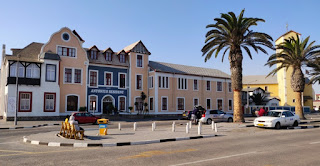Riding in the southern regions, one hardly crosses anyone. Except for some gas stations at crossroads between major gravel highways, no sign of villages around.
And, then, the interlude of the odd gravel road with gates which you need to open by yourself every 2-5 km.
One fascinating desert after the other and then a few cities. Swakopmund, Walvis Bay and more north Tsumeb and Grootfontein: neat, green, orderly, well maintained, with the most equipped pharmacies and medical practices. Incongruous, in a way. Not the image one has of cities in Africa.
But head northwards and cross the red line of animal disease prevention and the country changes dramatically. No more dried up prehistoric waterways but real rivers, forests of trees, cattle grazing by the (tarred) highway. And villages and schools scattered around, people walking by the road and children waving at cars.
Cities in the north look different too. Take Rundu: markets, noise and music, dusty roads, and neighbourhoods of huts made of mud or zinc, alongside neighbourhoods of houses made of bricks. And in some places the sad view of plastic garbage as if growing from trees and plants.
Another country, probably poorer, more humid, where malaria has not yet been eradicated, inhabitants are mostly farmers, when they do not move south to work for the tourism industry.
Beautiful in a different way, where you can sit on the side of the river Okavango looking at Angola on the other side.
Or going further east, taking your time to spot hippos bathing on the other side or warthogs happily having breakfast, while birds of all colours fly in and out of your room














